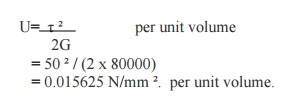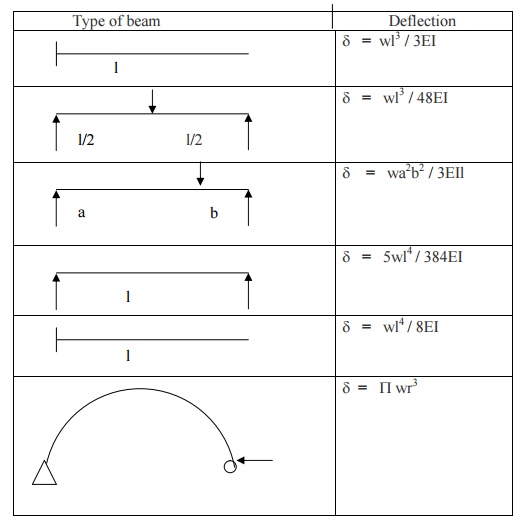Chapter: Civil : Strength of Materials : Energy Principles
Important Questions and Answers: Civil - Strength of Materials - Energy Principles
1.Define: Strain Energy
When an elastic
body is under the action of external forces the body deforms and work is done
by these forces. If a strained, perfectly elastic body is allowed to recover
slowly to its unstrained state. It is capable of giving back all the work done
by these external forces. This work done in straining such a body may be regarded
as energy stored in a body and is called strain energy or resilience.
2. Define: Proof Resilience.
The maximum energy stored in the body within the
elastic limit is called Proof
Resilience.
3. Write the formula to calculate the strain
energy due to axial loads ( tension).

Where,
P = Applied tensile load.
L =
Length of the member
A = Area of the member
E = Young's modulus.
2. Write the formula to calculate the strain energy due to bending.

Where,
M = Bending moment due to applied loads.
E = Young's modulus
I = Moment of inertia
3. Write the formula to calculate the strain energy due to torsion

Where, T = Applied Torsion
G = Shear modulus or Modulus of rigidity
J = Polar moment of inertia
6.Write the formula to calculate the strain
energy due to pure shear

Where,
V= Shear load
G = Shear modulus or Modulus of rigidity
A = Area of cross section.
K = Constant depends upon shape of cross
section.
7. Write down the formula to calculate the
strain energy due to pure shear, if shear stress is given.

![]() Where, ? = Shear Stress
Where, ? = Shear Stress
G = Shear modulus
or Modulus of rigidity V = Volume of the material.
8. Write down the formula to calculate the
strain energy , if the moment value is given

Where, M = Bending moment
L = Length of the beam
E = Young's modulus
I = Moment of inertia
9. Write down the formula to calculate the
strain energy , if the torsion moment value is given.

Where, T = Applied Torsion
L = Length of the beam
G = Shear modulus
or Modulus of rigidity J = Polar moment of inertia
10. Write down the formula to calculate the
strain energy, if the applied tension load is given.

Where,
P = Applied tensile
load. L = Length of the member
A = Area of the member
E = Young's modulus.
11. Write the Castigliano's first
theorem.
In any beam or truss subjected to any load
system, the deflection at any point is given by the partial differential
coefficient of the total strain energy stored with respect to force acting at a
point.

Where,
? = Deflection
U= Strain Energy stored
P = Load
12. What are uses of Castigliano's
first theorem?
1.
To determine the deflection of
complicated structure.
2.
To determine the deflection of
curved beams springs.
13.
Define: Maxwell Reciprocal Theorem.
In any beam or truss the deflection at
any point 'A' due to a load 'W' at any other point 'C' is the same as the
deflection at 'C' due to the same load 'W' applied at 'A'.

13. Define: Unit load method.
The external load
is removed and the unit load is applied at the point, where the deflection or
rotation is to found.
15.
Give the procedure for unit load
method.
1. Find the forces P1, P2, ……. in all the members due to external
loads.
2.
Remove the external loads and apply
the unit vertical point load at the joint if the
vertical deflection is required and find the
stress.
3.
Apply the equation for vertical and
horizontal deflection.
16.
Compare
the unit load method and Castigliano's first theorem
In the unit load method,
one has to analyze the frame twice to find the load and deflection. While in
the latter method, only one analysis is needed.
17.
Find the strain energy per unit
volume, the shear stress for a material is given as 50 N/mm ². Take G= 80000
N/mm ²

=
50 ² / (2 x 80000)
=
0.015625 N/mm ². per unit volume.
18.Find the strain energy per unit volume, the
tensile stress for a material is given as 150 N/mm ². Take E = 2 x10 N/mm ².

=
(150) ² / (2 x (2x10 ² )
=
0.05625 N/mm ². per unit volume.
19.Define : Modulus of resilience.
The proof
resilience of a body per unit volume. (ie) The maximum energy stored in the
body within the elastic limit per unit volume.
20. Define : Trussed Beam.
A beam strengthened
by providing ties and struts is known as Trussed Beams.
21. Deflection of beams

Related Topics